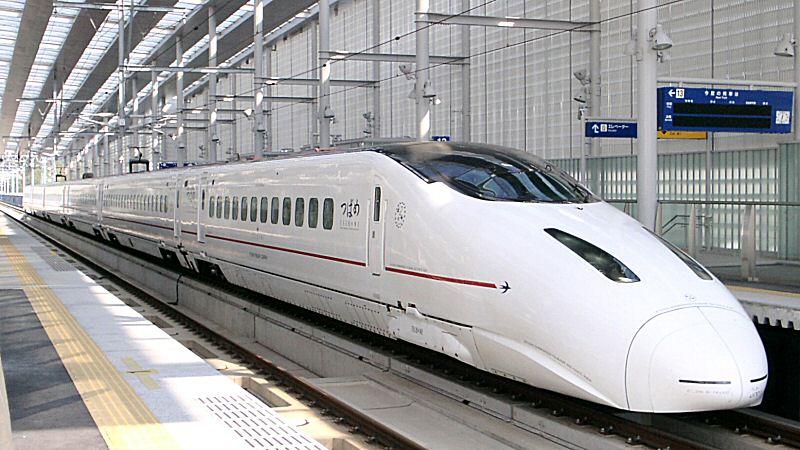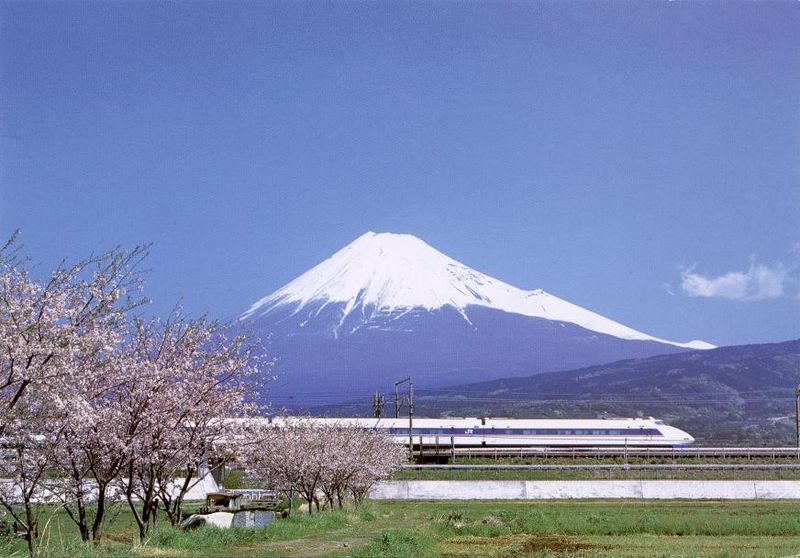| Actualite |
Shinkansen
par Raphael
The shinkansen, Japan’s bullet train, is not only a domestic symbol of Japanese ingenuity and craftsmanship, but is admired throughout the world for its speed and safety. In 2009, the shinkansen celebrated its 45th anniversary, and since shinkansen service began in Japan, the high-speed trains have served over 8 billion passengers, which is more than the population of the world. Shinkansen technology is spreading throughout the world, and the extensive high-speed railway infrastructure in Japan makes it the transportation envy of the world.
The largest hub for shinkansen transport in Japan is Tokyo station, from which a shinkansen departs every few minutes. There are over 600 arrivals and departures each day for shinkansen alone, meaning that Tokyo station is one of the busiest train stations in the world. The shinkansen trains are extremely punctual, as well. On average, each train is no more than ten seconds early or late, allowing passengers the peace of mind in knowing that their trip will take place exactly as scheduled. Crowds of train fans often appear to see shinkansen off, particularly at special events, where photography of the trains is particularly popular.
Shinkansen trains are known for their speed, comfort, and beauty. Their distinctive aerodynamic shape makes them easily recognizable, and shinkansen merchandise appears everywhere from expensive models to children’s toys, to goods like lunchboxes. Shinkansen trains and goods are popular with adults and children alike. Each train is distinctive, too, with regional nicknames and even décor that represents local tastes. The Kagoshima train known as “Tsubame,” or “Swallow,” for instance, features gold-leaf walls, lacquer decorations, and real wood seat trays. Each region is proud of the shinkansen that serves it, which is almost like a mascot for the area.
The shinkansen tracks extend 2387 kilometers: the full length of Honshuu, and into Kyuushuu to the south. The 1196 kilometer trip from Tokyo to Hakata takes only five hours aboard one of the N700 series bullet trains, making long distance travel quick and easy. Shinkansen trains can safely reach speeds of 320 kilometers per hour. Safety is also a key concept for the shinkansen, which has suffered no fatal accidents through operator error, derailment, or collision in its entire history. A detailed system prevents collision by automatically sensing the distance between two trains and slowing the following train to 30 km/h if the distance is less than one kilometer. If the distance continues to close, the train is stopped entirely, ensuring the safety of the passengers aboard. A special train runs along the tracks to inspect conditions of the tracks and cables, and every night more than 3000 workers check the tracks to ensure that they are in perfect condition. The trains are also designed to be earthquake-resistant, and to operate safely even on Japan’s most demanding mountain slopes.

The first generation of shinkansen trains was constructed in 1964. Japan’s economy was reviving in the wake of World War II and the country was preparing to host the Olympics that year. Rapid urbanization taxed the transportation infrastructure, and fast public transportation was highly in demand. Plans were created to construct a train that could travel between Tokyo and Osaka in three hours or less. This train would have to outdo the famous French “Mistral,” which at the time was the fastest train in the world with a top speed of 120 km/h.
Many of the shinkansen’s original engineers had once worked toward the war effort. Miki Tadanao, the designer of the body of the first train, had once worked on kamikaze planes, but in the post war wished to turn his talents toward a peaceful enterprise. His experience designing airplanes lead him to invent the streamlined shape that imbued the shinkansen with its record-breaking speed, as well as its distinctive bulbous-nosed appearance. Because the engineers wanted to achieve a top speed of 200 km/h, they had to invent a revolutionary spring suspension to minimize dangerous horizontal vibrations of the wheels. On March 30, 1963, the shinkansen was given a trial run, and its top speed clocked in at an impressive 256 km/h, making it the fastest train in the world. In 1964, the train was put into service. Suggestions for a name were solicited from the public and the most popular suggestion was used: “hikari,” meaning “light.” For a nation that had been ravaged by war and starvation, this peaceful triumph of technology was a bright ray of hope pointing toward the future.
There is a shinkansen subculture of train fans who excitedly follow the development of the trains, buy shinkansen merchandise, enjoy working with model trains as a hobby, and especially like taking pictures of the shinkansen trains. Taking a picture of the shinkansen in motion is very difficult because of the high speed at which they travel. Particularly prized are photos that include the entire train. The shinkansen passes by so quickly that getting the perfect shot of one is almost impossible, but there are many who make it their hobby or their business to try.
From Japan, shinkansen technology is expanding outward to the rest of the world. In 2007, Taiwan unveiled their high-speed railway, which uses shinkansen technology. The same year, China also adopted the shinkansen. In 2009, Vietnam announced its intention to institute a shinkansen system. Even the United States of America seems interested lately, as Obama has proposed expanding train infrastructure in America in order to create jobs. While the French TGV, with a top text speed of 574.8 km/h , is the shinkansen’s top competitor, shinkansen trains have reached speeds of at least 500 km/h in testing, and their popularity is only increasing.

Photos credits:
- http://commons.wikimedia.org/wiki/File:Kyusyushinkansen_type800_shinminamata.jpg
- http://commons.wikimedia.org/wiki/File:Mountfujijapan.jpg
- http://commons.wikimedia.org/wiki/File:E5_S11_Sendai_20090725.JPG
| Aucun commentaire |


















